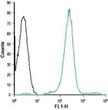C3AR1 Rabbit Polyclonal Antibody
Other products for "C3AR1"
Specifications
| Product Data | |
| Applications | FC, WB |
| Recommended Dilution | WB: 1:200-1:2000; IHC: 1:100-1:3,000; FC: 1:50-1:600 |
| Reactivities | Human |
| Host | Rabbit |
| Clonality | Polyclonal |
| Immunogen | Peptide (C)EDHETSPLDNSD, corresponding to amino acid residues 276-287 of human C3a anaphylatoxin receptor. 2nd extracellular loop. |
| Formulation | Lyophilized. Concentration before lyophilization ~0.8mg/ml (lot dependent, please refer to CoA along with shipment for actual concentration). Buffer before lyophilization: Phosphate buffered saline (PBS), pH 7.4, 1% BSA, 0.05% NaN3. |
| Purification | Affinity purified on immobilized antigen. |
| Conjugation | Unconjugated |
| Storage | Store at -20°C as received. |
| Stability | Stable for 12 months from date of receipt. |
| Gene Name | complement component 3a receptor 1 |
| Database Link | |
| Background | The innate immune system identifies pathogens by recognizing known elements. This response ultimately leads to the production of proinflammatory substances and the activation of phagocytic neutrophils and macrophages. Activation of the complement system is an important initial even in the response against pathogens. This system includes some thirty different proteins that act together to form a complex. Three different pathways are known to activate the complement. The C3 complement plays a key role in all three pathways leading to the activation of the complement. Produced in the liver, C3 is the most abundant complement protein in the serum. It is composed of two polypeptides, an α and β chain. Cleavage of C3 leads to the production of C3b and C3a. C3a binds to C3a receptor, a G-protein coupled receptor which couples to Gi upon activation. Like all other members of the superfamily, C3a receptor has seven transmembrane domains with an extracellular N-terminus and intracellular C-terminal tail. The receptor has two glycosylation sites, an unusually large extracellular loop with a sulfated tyrosine residue important for ligand recognition and binding. C3a receptor is expressed in cells of myeloid origin like neutrophils, macrophages and dendritic cells to name a few. It is also detected in astrocytes from inflamed brain, endothelial cells and activated human T cells. mRNA of C3a receptor is detected in lung, liver, kidney, brain heart, muscle and testis. |
| Synonyms | AZ3B; C3AR; HNFAG09 |
| Reference Data | |
| Protein Families | Druggable Genome, GPCR, Transmembrane |
| Protein Pathways | Complement and coagulation cascades, Neuroactive ligand-receptor interaction |
Documents
| Product Manuals |
| FAQs |
{0} Product Review(s)
0 Product Review(s)
Submit review
Be the first one to submit a review
Product Citations
*Delivery time may vary from web posted schedule. Occasional delays may occur due to unforeseen
complexities in the preparation of your product. International customers may expect an additional 1-2 weeks
in shipping.






























































































































































































































































 Germany
Germany
 Japan
Japan
 United Kingdom
United Kingdom
 China
China




